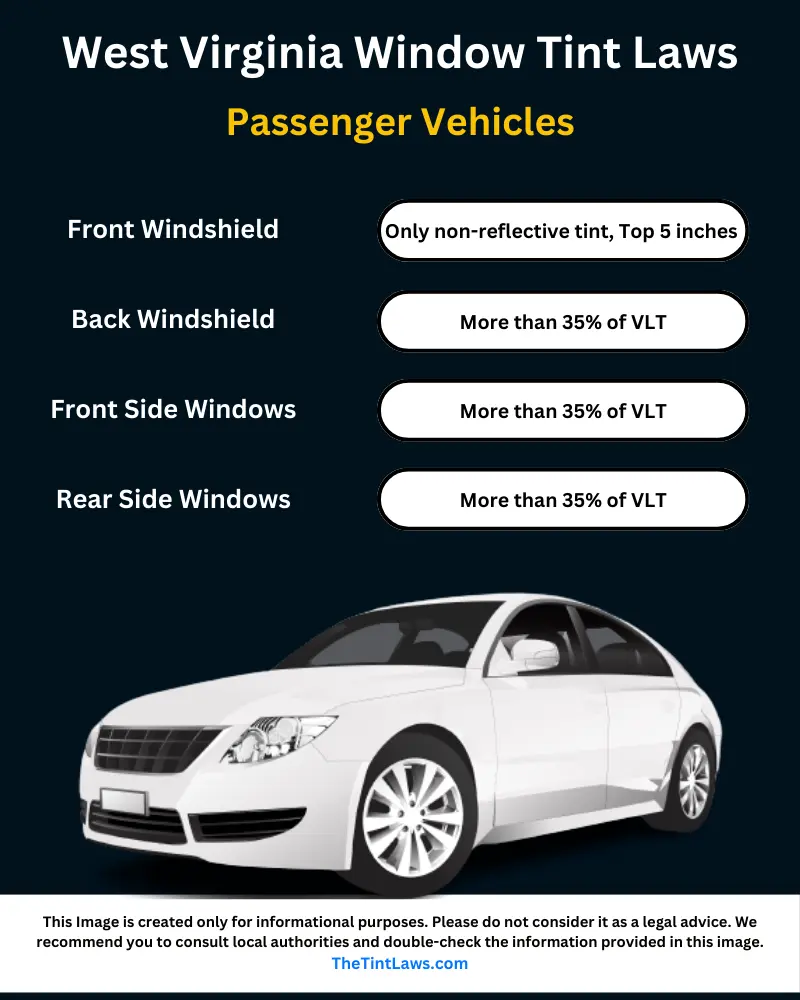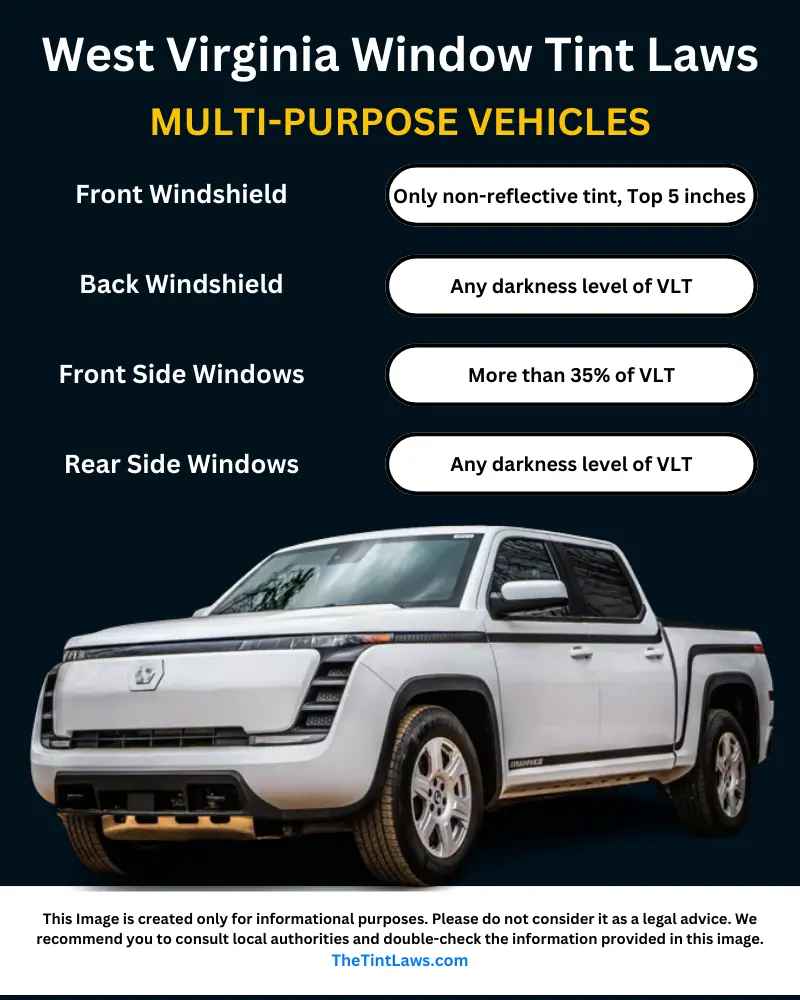Dreaming of a cooler, more comfortable ride in West Virginia’s heat? Window tint can be a game-changer. However, to avoid a roadside hassle, familiarizing yourself with West Virginia tint laws is key.
This guide will break down the regulations for window tinting in the Mountain State, ensuring your car stays legal and you can cruise comfortably on every adventure.
Window tint laws in West Virginia were enacted in 1991. The darkest legal tint in West Virginia is 35% for all windows except the front windshield.
West Virginia Tint Laws:
The legal tint darkness is measured by Visible Light Transmission (VLT), which indicates the percentage of light that passes through the film. Here’s a breakdown of the legal VLT limits for different types of vehicles.
Legal tint darkness for sedans:
- Windshield: Only non-reflective tint is allowed on the top 5 inches.
- Front side windows: More than 35% of VLT should be allowed.
- Back side windows: More than 35% of VLT should be allowed.
- Rear window: More than 35% of VLT should be allowed.

Legal tint darkness for SUV and Van:
- Windshield: Only non-reflective tint is allowed on the top 5 inches.
- Front side windows: More than 35% of VLT should be allowed.
- Backside windows: Any darkness level is permitted.
- Rear window: Any darkness level is permitted.

Important Note: It’s crucial to remember that these are the minimum VLT requirements. You can have lighter tint (higher VLT percentage) as long as it meets the legal limit. However, anything darker than the specified VLT is considered illegal.
Window Tint Reflection in West Virginia:
West Virginia tint laws allow a certain percentage of tint reflection for all types of vehicles.
Tint Reflection for sedans:
- Front side windows: It should not be more reflective than 20%.
- Back Side windows: It should not be more reflective than 20%.
Tint Reflection for SUV and Van:
- Front side windows: It should not be more reflective than 20%.
- Back Side windows: It should not be more reflective than 20%.
West Virginia Window Tinting Rules and Regulations:
- Side mirrors: Both side mirrors are required in case of rear window tint.
- Restricted Colors: It is illegal to use red, amber, and yellow colors. Any other color can be used for tinting purposes.
- Certificates: A certificate showing the tint’s specifications must be provided by the installer.
- Stickers: A tint certification sticker must be placed on the lower left corner of the driver’s side window.
Medical exemption for Window Tinting:
West Virginia offers exemptions for individuals with specific medical conditions that require protection from sunlight. By obtaining a medical exemption, you can tint your windows to a darker shade while staying within the legal boundaries.
Consequences of Non-Compliance:
- Citations and Penalties: A citation for violating the tint law can lead to a maximum fine of $200.
- Correction Orders: You may be issued a correction order, requiring you to remove the illegal tint or have it adjusted to meet the legal VLT specifications.
Tint Laws Reference: West Virginia Code. CHAPTER 17C. TRAFFIC REGULATIONS AND LAWS OF THE ROAD.
Information about West Virginia State
West Virginia, located in the southeastern region of the United States, shares its borders with Virginia, Kentucky, Ohio, Pennsylvania, and Maryland. Nestled in the Appalachian Mountains, West Virginia boasts stunning scenery with dramatic valleys and verdant forests. The state experiences all four seasons, with hot, humid summers and cold, snowy winters.
It is the 41st largest US state by land area and the 39th most populous (estimated 2023) state in the United States. The largest city is Charleston.

Capital
Charleston
Population
1,770,071 (2023)
Area
24,230 mi2 (62,755 km2)
Cities in West Virginia State
Charleston, Morgantown, Huntington, Martinsburg, Wheeling, Beckley, Parkersburg, Harpers Ferry, Clarksburg, Snowshoe, Charles Town, Fairmont, Bluefield, Elkins, Lewisburg, Bath, Sunlight, Shepherdstown, Point Pleasant, Weirton, Spice, Buckhannon, Princeton, Bridgeport, Falling Waters, Reader, Moundsville, White Sulphur Springs, Hurricane, Paw Paw, Summersville, Mannington, Barboursville, Poca, Sophia, Coalwood, Fayetteville, Nitro, Woodman, Bomont, West Virginia, Keyser, Welch, Green Bank, Kabletown, Weston, Logan, New Martinsville, Oceana, St. Albans, Williamson
Counties in West Virginia State
Barbour, Berkeley, Boone, Braxton, Brooke, Cabell, Calhoun, Clay, Doddridge, Fayette, Gilmer, Grant, Greenbrier, Hampshire, Hancock, Hardy, Harrison, Jackson, Jefferson, Kanawha, Lewis, Lincoln, Logan, Marion, Marshall, Mason, McDowell, Mercer, Mineral, Mingo, Monongalia, Monroe, Morgan, Nicholas, Ohio, Pendleton, Pleasants, Pocahontas, Preston, Putnam, Raleigh, Randolph, Ritchie, Roane, Summers, Taylor, Tucker, Tyler, Upshur, Wayne, Webster, Wetzel, Wirt, Wood, and Wyoming.